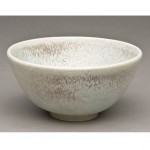Harding Black is best known for his glaze research, and the significant contributions that he made to the American studio ceramics movement in the early 20th century. As a young man, he became interested in ceramics after joining an expedition to excavate ancient Native American mounds near Big Bend, Texas, sponsored by the Witte Museum. These early explorations set Black on the path to rediscovering some of the ancient world’s most elusive glazes.
Black had no formal training in the fields to which he dedicated his life. He was taught to throw clay by his friend Rudolf Staffel, who would himself go on to be recognized as a master ceramist. Early in his career, Black taught children’s ceramics classes at San Antonio’s Witte Museum, and also supervised projects for the Works Progress Administration.
Although Black was capable of producing remarkable ceramic forms such as bowls, vases, and sculptures, his true passion, and indeed the foundation of his legacy, lay in glaze research. Black was a tireless researcher, and shared his findings with all who asked.
Black’s fascination with ancient glazes would lead him to significant developments in Eastern glazes such as copper reds, celadons and oilspots, along with Western glazes, such as lava glazes and Scandinavian satin mattes.














